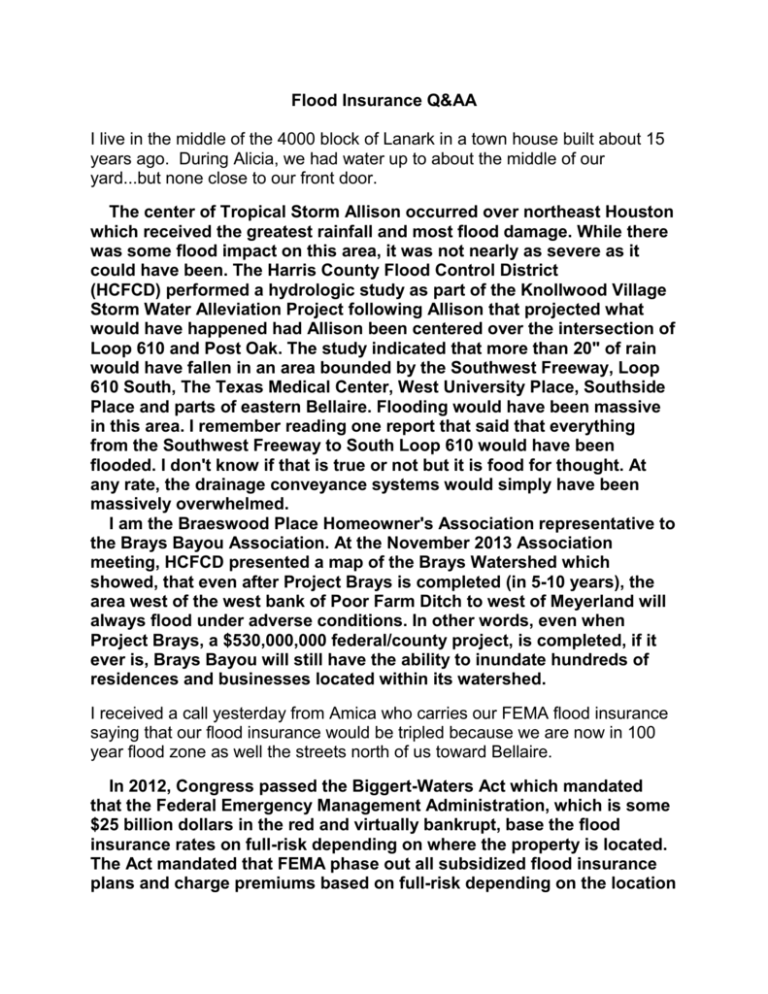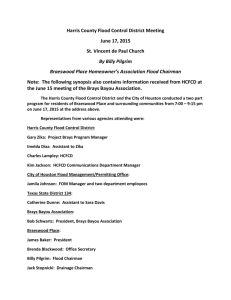more information - Braeswood Place Homeowners Association
advertisement

Flood Insurance Q&AA I live in the middle of the 4000 block of Lanark in a town house built about 15 years ago. During Alicia, we had water up to about the middle of our yard...but none close to our front door. The center of Tropical Storm Allison occurred over northeast Houston which received the greatest rainfall and most flood damage. While there was some flood impact on this area, it was not nearly as severe as it could have been. The Harris County Flood Control District (HCFCD) performed a hydrologic study as part of the Knollwood Village Storm Water Alleviation Project following Allison that projected what would have happened had Allison been centered over the intersection of Loop 610 and Post Oak. The study indicated that more than 20" of rain would have fallen in an area bounded by the Southwest Freeway, Loop 610 South, The Texas Medical Center, West University Place, Southside Place and parts of eastern Bellaire. Flooding would have been massive in this area. I remember reading one report that said that everything from the Southwest Freeway to South Loop 610 would have been flooded. I don't know if that is true or not but it is food for thought. At any rate, the drainage conveyance systems would simply have been massively overwhelmed. I am the Braeswood Place Homeowner's Association representative to the Brays Bayou Association. At the November 2013 Association meeting, HCFCD presented a map of the Brays Watershed which showed, that even after Project Brays is completed (in 5-10 years), the area west of the west bank of Poor Farm Ditch to west of Meyerland will always flood under adverse conditions. In other words, even when Project Brays, a $530,000,000 federal/county project, is completed, if it ever is, Brays Bayou will still have the ability to inundate hundreds of residences and businesses located within its watershed. I received a call yesterday from Amica who carries our FEMA flood insurance saying that our flood insurance would be tripled because we are now in 100 year flood zone as well the streets north of us toward Bellaire. In 2012, Congress passed the Biggert-Waters Act which mandated that the Federal Emergency Management Administration, which is some $25 billion dollars in the red and virtually bankrupt, base the flood insurance rates on full-risk depending on where the property is located. The Act mandated that FEMA phase out all subsidized flood insurance plans and charge premiums based on full-risk depending on the location of the property. Property owners which are impacted the most are those who live in coastal areas, towns and cities. It should be noted that the increase in insurance premiums is a nationwide mandate and not directed solely toward locations such as Houston, Galveston and other sites located in a 100-year flood plain. Prior to 2003, our area was considered to be in the 500-year flood plain. FEMA resurveyed Harris County in 2003 and nearly all of the area in the Brays Watershed became a part of the 100-year flood plain although there are areas, which I call "islands", which are above the flood plain located within the geographic Brays Bayou 100-year flood plain. You can Google the Biggert-Waters Act and get some understanding of what it entails. However, Congress recently delayed the imposition of the increased rates by, if I remember correctly, requiring that the rate increases be phased in incrementally over the next few years. Without that, the rate of increase, depending on where the property is located, was slated to increase as much as five-fold in coming years. That would have devastated the real estate market with no one being able to buy or sell a property as a result. I've talked to real estate agents who have told me that increased flood insurance requirements are deal breakers because purchasers are not willing to pay the premiums required to qualify for a mortgage, and they can't get one without coverage. Property owners in coastal areas such as Galveston, Texas City, Dickinson, etc., are facing the probability of having to pay as much as $30,000-$40,000 per year for flood insurance. Property owners in our area do not face such a Draconian increase, but our rates will increase never the less. There are several ways to challenge the rate increases which are spelled out in the Biggert-Waters Act. However, I don't think your residence would qualify since it is not that old. These are spelled out in the act. Amica said I might could call a surveyor who measured heights (Hope I'm saying this correctly) and might...might?...get a reduction of the insurance bill. What Amica is referring to is contacting a civil engineering firm and requesting an Elevation Certificate survey be performed at your residence. Many Braeswood Place property owners have done this and I highly recommend it. The survey only takes a short time for the engineer to do and should cost in the neighborhood of $250-$300. The completed survey will show what the elevation of the top of your foundation (floor) at your front door is compared to what the expected level of inundation at that location. I live on Castlewood Street and our street has never flooded in the 40 years we have lived here. However, that doesn't mean that it won't or can't flood should an extraordinary rain event occur in this area or to our west. We, and several of our neighbors, have had the elevation surveys done. All of us now have Elevation Certificates noting that our residences are above the 100-year floodplain. They are the one item we have to challenge increased rates. We used to purchase flood insurance through State Farm. State Farm stopped underwriting flood insurance several years ago. We now purchase flood insurance directly from FEMA. However, our State Farm agent instructed us to send a copy of our Elevation Certificate for record. My townhouse neighbor says he will just not pay for that increase and will go without the insurance because if we didn't flood during Alicia, we probably will never flood. Whether or not to purchase flood insurance is a personal issue. If a property owner owns his/her residence free and clear, he/she is not required to purchase flood insurance. Property which is financed by a mortgage is always required to be covered by flood insurance. It would be nearly impossible to obtain a mortgage without also having to purchase flood insurance. It boils down to how much risk a person is willing to take. I said above that my neighbors and I have had elevation surveys performed. As a result several of them have dropped their flood insurance because they own their homes outright. I strongly disagree with the concept that since we haven't flooded before we will never flood. The area of Harris County we live in will always be subject to flooding. There simply isn't, and never will be, enough money to build our way out of flooding. I cited the hydrologic study above but there is an even greater potential for a disastrous flood event in our area. While Tropical Storm Allison caused flooding in our area, i.e., 550 homes in Braeswood Place, 1,500 homes in Bellaire, more than 1,000 in West U and Southside, the amount of rain that fell in this area wasn't the primary cause of the flooding. The cause was simply that the water couldn't reach the conveyance systems, i.e., storm drains, Poor Farm Ditch, Kilmarnock Ditch, etc. As a result, the water, called "sheet flow" was unable to get to Brays Bayou via the conveyance system infrastructure. Brays Bayou was not the cause of the flooding that occurred during Allison. Had the water been able to reach the conveyance systems, flooding would have been lessened that what actually occurred. The scenario that worries me the most is a hurricane coming ashore along the coast south of our location. That would put us on the "wet side" where the greatest rainfall and tornado activity occurs. Brays Bayou can handle about 10" of rain in a 24-hour period, but with a hurricane all bets are off. If that should happen and the system moves, or stalls out, west of the Houston area, we would be in for big trouble. At one of the BBA meetings last year, Harris County Commissioner Steve Radack said that if a Category 4 or 5 hurricane came ashore at Galveston and proceeded up the Houston Ship Channel to Houston, storm surge flooding would be inestimable and thousands of people would die. He said buildings in downtown Houston would be falling down. Our refining and chemical manufacturing industry, which supplies almost 50% of the total energy required by our nation, would be wiped out. It would create an environmental disaster. Environmental contamination from ruptured storage tanks and process equipment would be a disaster of proportions from which the industry would never recover. That makes the Ike Dike or Centennial Gate all the more important consideration. Unfortunately, all that's being done at the present is just to talk about it but currently it appears that the choice will be the Centennial Gate which would be located at the Fred Hartman Bridge. If you are interested, you can Google that and get more details. The lady at BPHA said you know more than anyone about this issue and might be able to give me some advice. I'd be grateful for any of your thoughts and advice. Although our Elevation Certificate shows our home to be above the 100-year flood plain and is owned free and clear, we haven't yet gotten comfortable with the idea of not purchasing flood insurance. As someone who is intimately knowledgeable about the potential for Brays Bayou flooding due to my association with the Brays Bayou Association and The Harris County Flood Control District and other entities, I'm not sure that we want to risk it all on the hope that there will never be a catastrophic flood in this area. Remember that the potential for flooding in a 100-year flood plain means that it could happen in any given year. My advice is to carefully consider what the ramifications would be if your residence is not covered by insurance in terms of the loss of the contents of your residence and having to replace them, having to pay the cost of repairs out of your own pocket, possibly having to find somewhere to live while all that is going on. To add to that burden, postflood repairs would require you to have to deal with the City of Flood Plain Management office which administers the flood plain rules/regulations. That office is extremely strict with the enforcement of its rules and regulations and dealing with it is no picnic.








